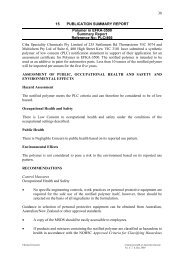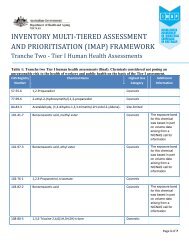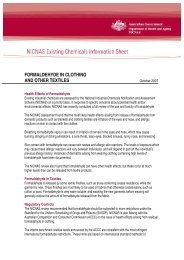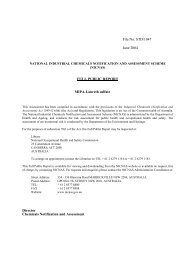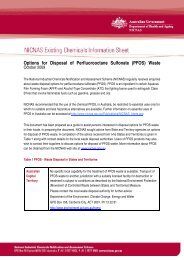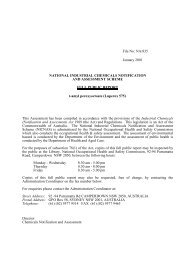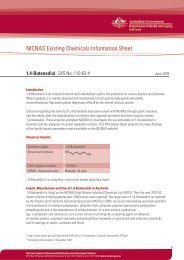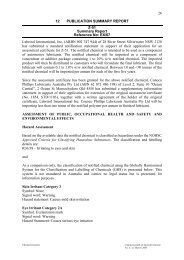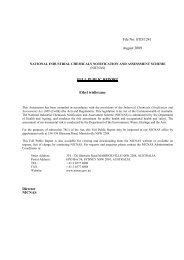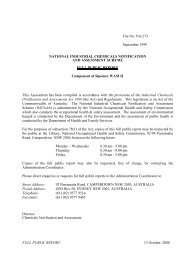GULFTENE C16-18 ISOMERISED OLEFINS - NICNAS
GULFTENE C16-18 ISOMERISED OLEFINS - NICNAS
GULFTENE C16-18 ISOMERISED OLEFINS - NICNAS
Create successful ePaper yourself
Turn your PDF publications into a flip-book with our unique Google optimized e-Paper software.
Comments on Physico-Chemical Properties<br />
Test reports were available only for C20 – C24 alkenes, branched and linear, which is similar<br />
to Gulftene 16-<strong>18</strong>, but consists of higher molecular weight alkenes. The tests were conducted<br />
in facilities that complied with OECD Principles of Good Laboratory Practice (GLP), and<br />
based on methods that complied with OECD test guidelines and or EC Directive 92/69/EEC<br />
(OECD 1995-1996), (European Commission 1992).<br />
Water solubility was also determined for the C20-24 blend. The solubility was determined by<br />
shaking aliquots of the chemical (approximately 0.1g) with 500 mL of distilled water at 30°C,<br />
and allowing these to stand and equilibrate at 20°C for more than 24 hours. The aqueous<br />
phase was then centrifuged, filtered and analysed for the compound using gas<br />
chromatography. The concentration of the mixture of C20-24 blend in water at 20°C was less<br />
than 17.5 µg/L (mean of three determinations). Gulftene 16-<strong>18</strong> contains lower molecular<br />
weight fractions than the C20-24 alkene mixture for which the water solubility was<br />
determined. Accordingly, the water solubility for Gulftene 16-<strong>18</strong> may be slightly higher than<br />
that for the C20-24 blend. However, low water solubility would be expected for hydrocarbon<br />
compounds of this nature.<br />
The vapour pressure of C20-24 alkenes branched and linear was determined using a vapour<br />
pressure balance based on the iseniscope method conducted by (Safepharm Laboratories<br />
Limited 1998), whereby a linear relationship is obtained from a plot of the logarithm of the<br />
equilibrium vapour pressure versus reciprocal temperature. This linear relation was<br />
determined on three separate samples of the material, and one typical result was –<br />
Log10 [vapour pressure (Pa)] = 4<strong>18</strong>0/Temperature (K) + 12.2<br />
The mean vapour pressure at 25°C from three such linear determinations gives a vapour<br />
pressure of less than 0.000017 kPa at 25°C. However, the tabulated result is for the C20-24<br />
mixture, and accordingly the measured vapour pressure is probably weighted towards that of<br />
the more volatile (lower molecular weight) components. It is probable that Gulftene 16-<strong>18</strong><br />
has a significantly higher vapour pressure than that indicated above because it consists of<br />
lower molecular weight components. In support of this, the OECD Screening Information<br />
Data Set (OECD 1992) for tetradecene gives the vapour pressure for this compound at 25°C<br />
as 0.0019 kPa.<br />
The Henry’s Law Constant is a measure of the degree of partitioning of a compound between<br />
the aqueous phase and the atmosphere and is calculated according to the relationship –<br />
H = Vapour pressure (Pa) x Molecular weight (g/mole)/Water solubility (g/m 3 ).<br />
Taking the water solubility as 20 µg/L, the vapour pressure as 1.7 x10 -5 kPa and using a<br />
molecular weight of 200 g/mole an estimate for H (at 25°C) is around 200 Pa m 3 /mole.<br />
However, it is likely that various components of Gulftene 16-<strong>18</strong> will have higher vapour<br />
pressures and would also have different (but still small) water solubilities. Consequently,<br />
while this value for H may be an underestimate, it is clear that the material would be<br />
appreciably volatile and tend to partition from the water phase to the atmosphere.<br />
FULL PUBLIC REPORT 26 April 2000<br />
NA/713 Page 6 of 100



